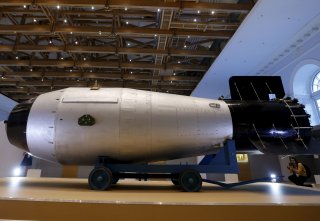How the Cold War Arms Race Meant Bigger and Bigger Bombs
But there was a limit to how far that could actually go.
The bombs prepared included a weaponized version of the Ivy Mike device—the liquid-fueled EC-16 hydrogen bomb, along with others trying out the new American dry fuel made of mixed Li-6 and Li-7 hydride. Scientist thought Lithium-6 was far less reactive to neutrons thrown from fission primaries and thus expected yields of six to ten megatons.
Nature (only partly) surprised them on the first test. The Castle Bravo shot yielded fifteen megatons—the biggest American nuclear test ever—and the worst radiological disaster in American history. It was two hundred and fifty times bigger than Hiroshima, Castle Bravo vaporized an island, contaminated three atolls and hundreds of people, caused major diplomatic incidents and introduced the word “fallout” into public discourse.
The size of the explosion resulted from Li-6's previously-unknown affinity for neutrons; the supposedly regular-gas bomb fuel turned out to be premium hi-test. Nature wasn't involved in another factor, the wind: despite warnings from meteorologists Test Director Alvin Graves ordered the shot fired. Graves, who had survived near-lethal radiation exposure, had little patience with those urging caution.
Despite the disaster the U.S. military carried on with Operation Castle, and conducted two of the other three biggest American tests. Unlike the land-based and heavily instrumented Castle Bravo test, Castle Romeo tested a weapon in its bomb casing mounted aboard a barge afloat in Bikini’s lagoon. The first test destroyed most of the test equipment on Bikini, and big test were blowing holes in Bikini’s reef. Because it used pure Li-6 hydride the Romeo shot was almost canceled; it became the third biggest American test at eleven megatons yield.
Castle Yankee was the second biggest American test at 13.5 megatons. As the fifth test of Operation Castle, Yankee again used a bomb casing on a barge, and again used the Li-6/Li-7 mixed fuel used in Castle Bravo. The 13.5 megaton blast produced a fireball four miles wide; 2.5 megatons of the 13.5 came from pure fusion alone.
The Castle Bravo, Romeo and Yankee tests proved the H-bomb design that became the first U.S. “city-killers”: high-yield thermonuclear weapons capable of completely destroying a target even if the weapon missed by miles. These Mk17 and Mk 24 bombs looked the part—nineteen feet long, five feet wide, ten tons heavy—big enough for a cowboy to ride into Armageddon.
Weapons development moved fast during those years. Only four years after Operation Castle, Operation Hardtack came to Bikini and Eniewetak Atolls as American weaponeers raced to test refined H-bomb designs before an unofficial testing moratorium announced by President Eisenhower. Hardtack Poplar, the fifth biggest American nuclear test, yielded 9.3 megatons from a bomb that would become the biggest ever deployed by the United States: the Mk-41 twenty-five-megaton three-stage device.
Hardtack Poplar tested only the first two stages, resulting in a very “clean” explosion—one with far less fallout. The third stage of the operational weapon was a internal casing of fissile uranium containing the first two stages; the immense neutron flux from the second-stage fusion explosion causes the third stage to fission and produce huge amounts of energy and radioactive waste. In Poplar the uranium casing was replaced with an inert lead one.
After Operation Hardtack the moratorium on testing delayed new designs, and when US testing resumed in 1962 no tests greater than four megatons are conducted. The United States turned to underground tests at the Nevada Test Site which is unable to contain megaton-class shots. The last known U.S. multi-megaton shot was Cannikin—a five-megaton blast a mile beneath Amchitka Island in the Aleutians.
Really huge nuclear weapons fell out of favor in America as missile accuracy increased. More accurate delivery platforms mean less need for big explosions to kill a target (and smaller delivery vehicles—a big warhead needs a big missile or plane or sub). But historian Alex Wellerstein notes that American bombs could have gotten much, much more powerful without growing bigger:
“By 1962, after the Dominic series, they thought they might be able to pull off 50 Mt in only a 4,500 kg (10,000 lb) package—a kind of ridiculous 11 kt/kg ratio.”
Could there have been a five-ton fifty Megaton bomb? It’s just as well that it was never (knowingly) explored. After all, the genie, however great, never stays in the bottle.
Steve Weintz, a frequent contributor to many publications such as WarIsBoring, is a writer, filmmaker, artist and animator.
(This is a combination of two previous articles posted last year. They are reposted here for your reading pleasure.)
Image: Reuters

